Mung bean dal in buttermilk curry is easy to make, and eating this dish may feel like giving your body and mind a calming spa treatment.
Hailing from Gujarat, a state on India’s northwestern coast, and known in India as khatta mung, this very popular mung bean dal is both comforting and sublime.
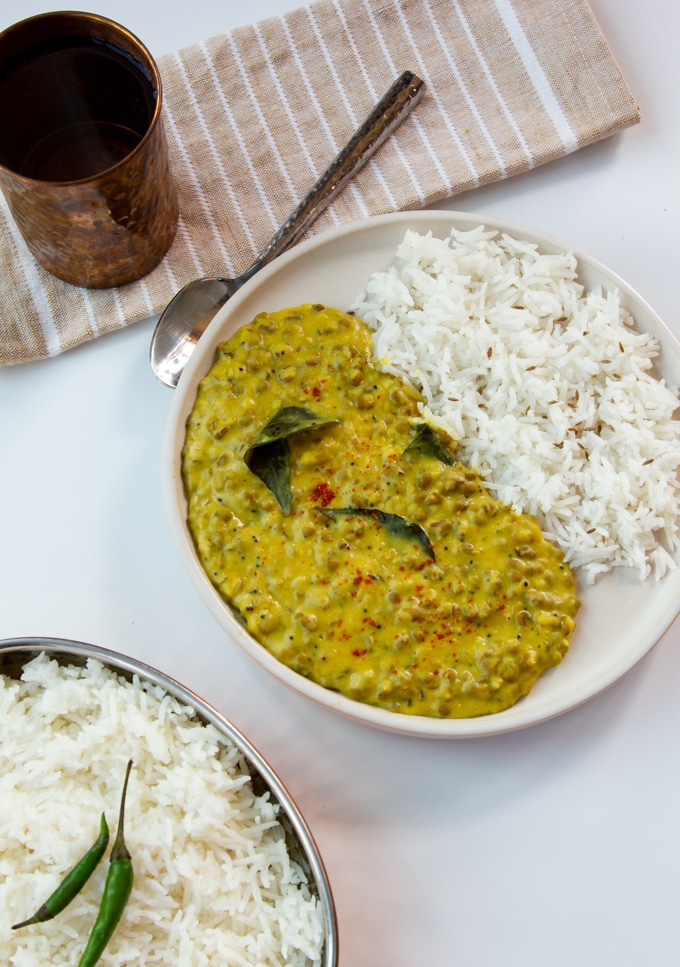
I love treating myself really well with food, and every time I make this dish, I find myself anticipating how good I will feel after eating it. Hopefully you will experience the same.
Contrary to the fact that buttermilk is in the name of this recipe, the ingredient that creates the creaminess is actually whole milk yogurt, which I think is a better choice since yogurt is a standard ingredient that most of you will have in your fridge already.
For my vegan readers, simply substitute with a plant-based yogurt alternative.
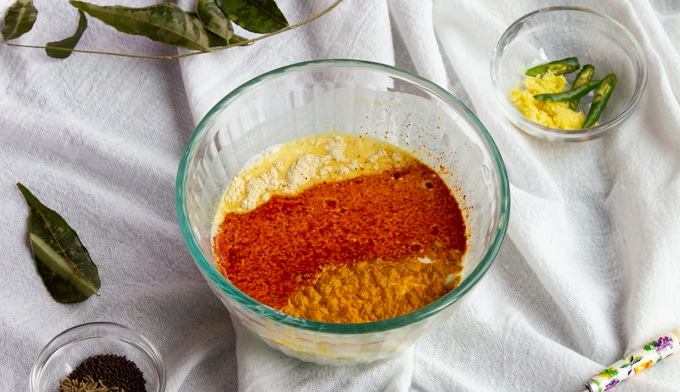
After the tangy yogurt is mixed with some spices, it becomes a lovely simmer sauce for the cooked mung beans.
This simple dish is really easy to digest, which gives your internal organs a break, and a chance to heal.
Pair this curry with some sautéed greens and basmati rice, and your satisfying vegetarian dinner is ready.
A sattvic dish
Mung bean dal in buttermilk curry is considered sattvic, or pure. One of the reasons is that it is made without onions or garlic.
Sattva is one of India’s traditional lifestyles. It is often associated with yogic or spiritual adherents, because eating sattvic food is said to bring clarity and calmness to the mind.
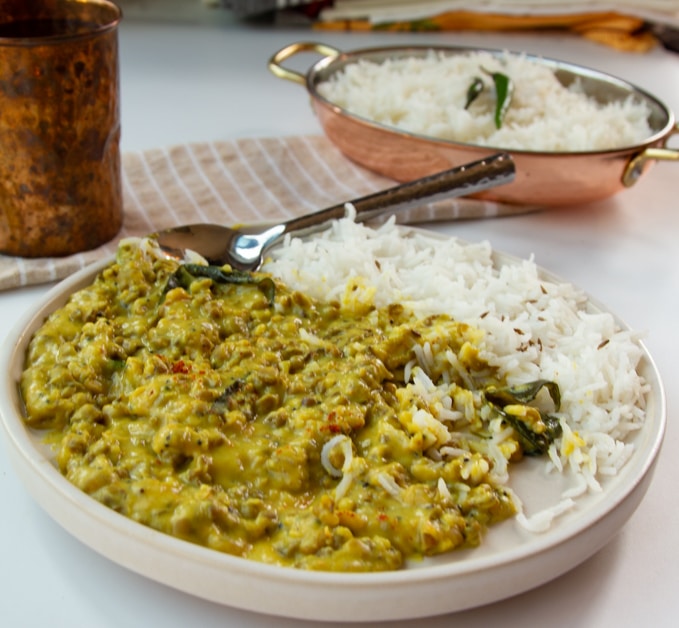
You don’t have to be a devout practitioner to have your own spirituality, so I encourage you to try this dish and see if you can feel any calming affect.
Another way to be consistent with sattvic principles is to choose fresh, locally-produced ingredients.
And when you cook, try to keep your mind calm and your thoughts positive.
If you want to read more about sattva, visit “What Is Mind-Body Cooking.”
Are you ready to start making this recipe? That's wonderful! Let's gather up the ingredients.
Where do I buy mung beans?
Mung beans are a staple in Indian, Chinese, Middle Eastern, and other Southeast Asian cuisines, so they are pretty easy to find at most grocery stores.
Or you can check this Amazon link for a good organic source.
You may also be interested to know that mung beans are revered in India as “the king of dal” for their supreme digestibility. Mung beans are also (not surprisingly) sattvic.
RECOMMENDED FOR YOU:
The Ultimate Guide To Indian Dal (Photo Glossary) —READ MORE
The spices
Depending on what the ingredients is, it will be available at a regular grocery story, an Indian grocery store, or online. Let me break it down to make it as easy as possible for you.
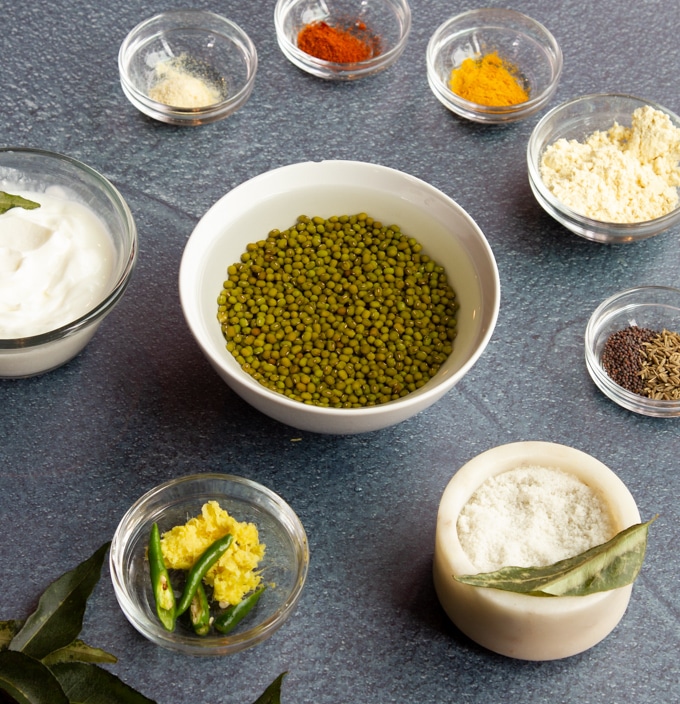
Spices you can get at ANY grocery store:
- chickpea flour (a substitute for gram flour)
- turmeric powder
- cayenne pepper (a substitute for red chili powder)
- cumin seeds
- ginger
- jalapeño (a substitute for green chili)
- fresh cilantro or coriander
- cayenne pepper powder (a substitute for red chili)
Spices you may need to get online, or at an Indian grocery store:
- gram flour (also known as besan or chickpea flour)
- red chili powder
- asafetida/hing (optional, but recommended)
- black mustard seeds
- green chilis
- curry leaves (optional, but recommended)
Check the Amazon recommendations below for the spices you need.
RECOMMENDED FOR YOU:
Don’t Have An Indian Ingredient? Indian Ingredient Substitutions —READ MORE
Other mung dal recipes
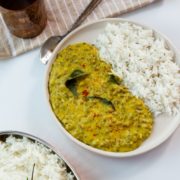
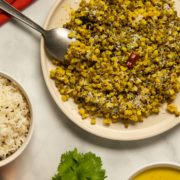
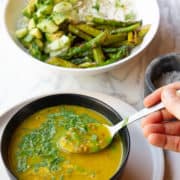
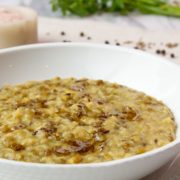
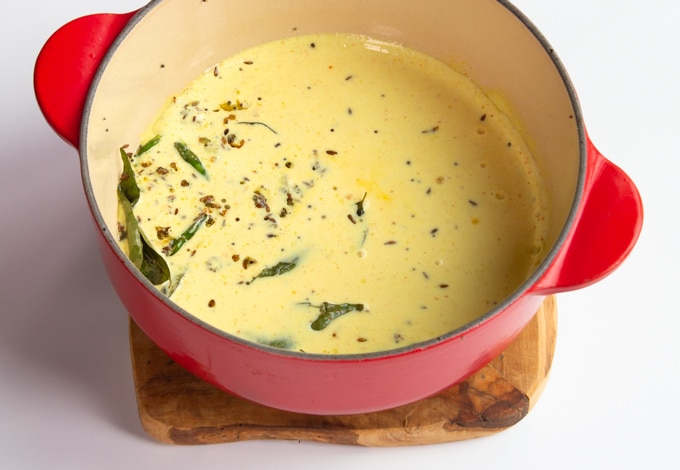
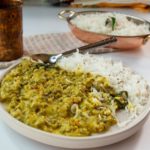
Recipe For Mung Bean Dal In Buttermilk Curry
Helpful Kitchen Tools:
Ingredients
- 1 cup whole mung beans
For the buttermilk sauce
- ½ cup plain whole milk yogurt , (or plant-based alternative; see notes)
- 2 tablespoons gram flour, (for thickening; see notes)
- ¼ teaspoon turmeric powder
- ⅛ teaspoon red chili powder , (substitute with cayenne pepper)
- ⅛ teaspoon asafetida, (optional; see notes)
- ½ teaspoon mineral salt
- 1 cup water
for the spice tempering
- 1 teaspoon vegetable oil
- ½ teaspoon black mustard seeds
- ½ teaspoon cumin seeds
- 2 green chilis (substitute with jalapeños), slit lengthwise
- 1 teaspoon ginger, finely chopped
- 5–6 curry leaves, (optional; see notes)
for the garnish
- 2 tablespoons fresh cilantro, finely chopped
Instructions
Cook the whole mung beans
- Cover mung beans with cold water and a pinch of salt, and soak for 4 hours or overnight. Drain off the soaking water and rinse well until the water runs clear.
- Decide whether you will cook the mung beans using a saucepan or Instant Pot. Note: Pressure cookers are amazing for cooking pulses quickly and efficiently. If you are unfamiliar with their use, please refer to my post on “How to Cook Beans From Scratch” for more information.
Saucepan method
- Add mung beans to a medium saucepan with 3 cups of cold water. Add turmeric powder and a pinch of salt, and bring to a boil. Turn down the heat, loosely cover the pot, and simmer for 50 minutes, or until the mung beans are soft and breaking apart. Keep an eye on it while simmering to ensure that the water does not evaporate below the level of the beans. If it does, add more water.
Pressure cooker Method ( Instant Pot or Stovetop)
- Add mung beans to a pressure cooker with 2 cups of cold water. Add a pinch of turmeric powder and a pinch of salt.
- INSTANT POT: Cover, select "High Pressure," and set the timer for 12 minutes on high pressure.STOVETOP COOKER: Cover, place the pressure regulator on the lid, and turn the heat to high. Once the cooker has reached high pressure, turn the heat down slightly, and cook for 8 minutes.
- Allow the pressure to come down naturally for 15 minutes. Manually release any remaining steam, and open the lid. The mung beans should be soft and breaking apart.
Make the buttermilk curry
- Whisk together the ingredients for the buttermilk sauce, including the yogurt, gram flour, turmeric powder, red chili, optional asafetida, and salt in a small mixing bowl until smooth with no lumps. Mix in 1 cup of water. Set aside.
- Temper the spices. Heat oil in a medium saucepan (large enough to hold the entire curry) on medium heat. Add the mustard seeds and cumin seeds and cook (watch carefully) until the mustard seeds start to pop. Add green chili, ginger, and optional curry leaves, and cook for another minute, until the ginger starts to brown slightly.
- Add the prepared buttermilk sauce and stir well. Bring to a boil, and then turn the heat to low and simmer for 10 minutes, stirring regularly. Add more water if needed to adjust the consistency if it gets too thick.
- Add the cooked mung beans to the sauce and continue to simmer for 3-4 minutes to integrate the flavors. Taste, and adjust for salt.
- Turn off the heat and garnish with chopped cilantro. Another option is to stir the cilantro into the curry. Either way it's delicious.
To serve
- Serve with basmati rice. Add a vegetable side and/or a green salad for a complete meal.
Notes
MAKE THIS VEGAN!
Substitute the whole milk yogurt with a plant-based yogurt of your choice. Recipe adapted from Archana Doshi of Archana’s KitchenNutrition
If you liked this post, please share it with your friends on social media, or leave a comment below.
For more Buttered Veg lifestyle content, follow me on Pinterest, Facebook, Instagram, and Twitter.
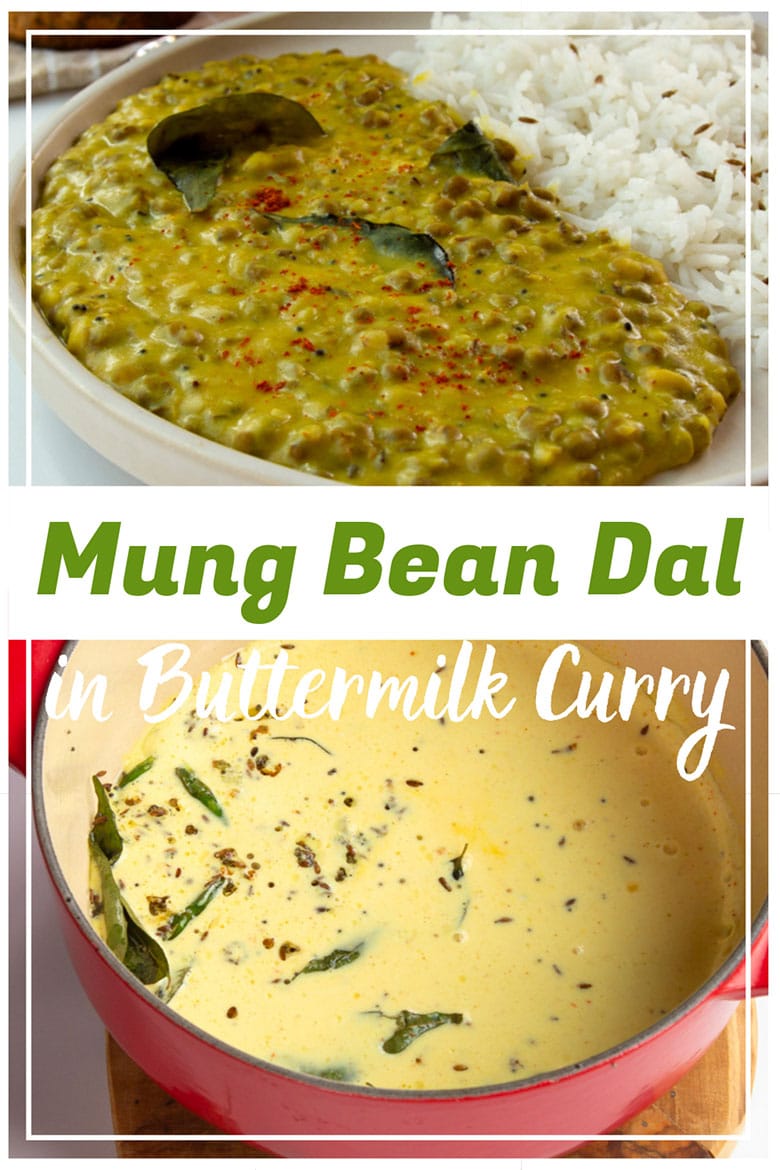

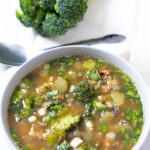
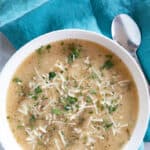
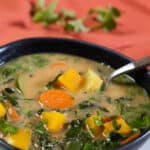
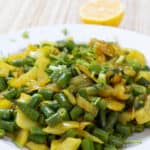
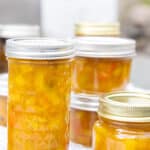
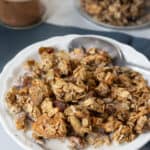
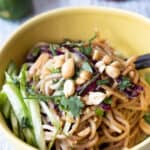

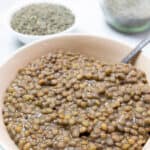
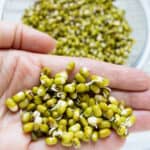
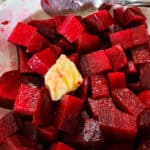

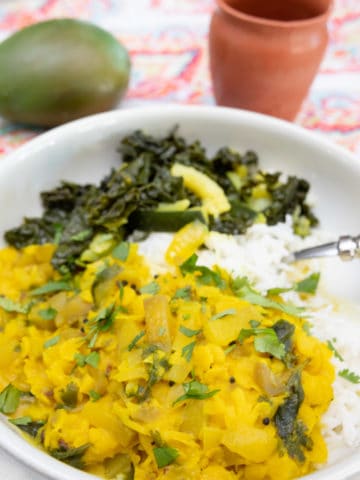
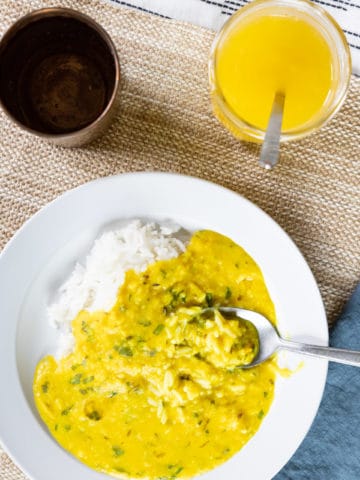
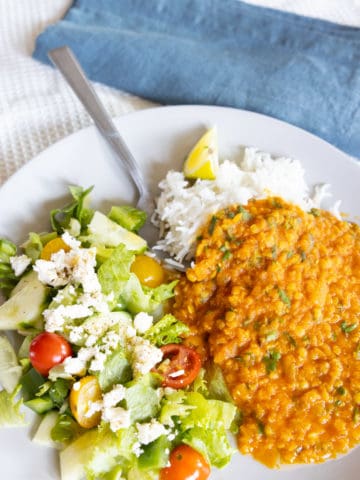
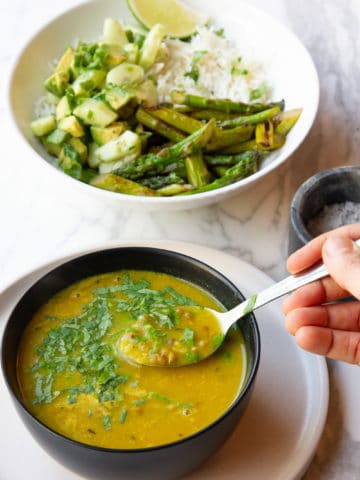
Michellel Ledesma
Hi Andrea, I'm on a mung bean kick lately and love your upkari. Am wanting to try this next. Two questions for you: will this also work if I sprout the mung beans first and how many curry leaves do you use? Thanks!
Andrea
Hi Michelle, Mung beans are one of the healthiest and easiest to digest legumes, so great you are on a kick. You can definitely use sprouted lentils to make this dal, and I use 5-6 curry leaves. Did I say in the post that I buy the fresh curry leaves from an Indian store and then store them in the freezer? It works great. Enjoy the dish! — Andrea
Ieuan
"Contrary to the fact that buttermilk is in the name of this recipe, the ingredient that creates the creaminess is actually whole milk yogurt, which I think is a better choice"
So it's *not* buttermilk curry. Why not just call it "Soothing Mung Bean Dal In Creamy Yoghurt Curry". That way, people like me won't end up at your page when looking for a recipe that actually does involve buttermilk.
Andrea
I am sorry that you were disappointed. It is a confusing thing, but to the best of my knowledge it is the correct terminology for this type of curry. "Buttermilk" as a drink if commonly made by blending a small amount of yogurt with water. It is a digestive enjoyed after meals, frequently with spices.